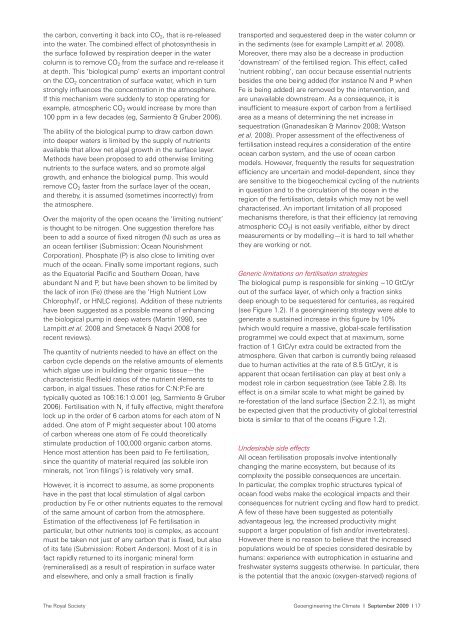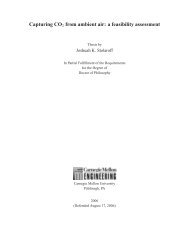Royal Society - David Keith
Royal Society - David Keith
Royal Society - David Keith
Create successful ePaper yourself
Turn your PDF publications into a flip-book with our unique Google optimized e-Paper software.
the carbon, converting it back into CO 2 , that is re-released<br />
into the water. The combined effect of photosynthesis in<br />
the surface followed by respiration deeper in the water<br />
column is to remove CO 2 from the surface and re-release it<br />
at depth. This ‘biological pump’ exerts an important control<br />
on the CO 2 concentration of surface water, which in turn<br />
strongly influences the concentration in the atmosphere.<br />
If this mechanism were suddenly to stop operating for<br />
example, atmospheric CO 2 would increase by more than<br />
100 ppm in a few decades (eg, Sarmiento & Gruber 2006).<br />
The ability of the biological pump to draw carbon down<br />
into deeper waters is limited by the supply of nutrients<br />
available that allow net algal growth in the surface layer.<br />
Methods have been proposed to add otherwise limiting<br />
nutrients to the surface waters, and so promote algal<br />
growth, and enhance the biological pump. This would<br />
remove CO 2 faster from the surface layer of the ocean,<br />
and thereby, it is assumed (sometimes incorrectly) from<br />
the atmosphere.<br />
Over the majority of the open oceans the ‘limiting nutrient’<br />
is thought to be nitrogen. One suggestion therefore has<br />
been to add a source of fixed nitrogen (N) such as urea as<br />
an ocean fertiliser (Submission: Ocean Nourishment<br />
Corporation). Phosphate (P) is also close to limiting over<br />
much of the ocean. Finally some important regions, such<br />
as the Equatorial Pacific and Southern Ocean, have<br />
abundant N and P, but have been shown to be limited by<br />
the lack of iron (Fe) (these are the ‘High Nutrient Low<br />
Chlorophyll’, or HNLC regions). Addition of these nutrients<br />
have been suggested as a possible means of enhancing<br />
the biological pump in deep waters (Martin 1990, see<br />
Lampitt et al. 2008 and Smetacek & Naqvi 2008 for<br />
recent reviews).<br />
The quantity of nutrients needed to have an effect on the<br />
carbon cycle depends on the relative amounts of elements<br />
which algae use in building their organic tissue—the<br />
characteristic Redfield ratios of the nutrient elements to<br />
carbon, in algal tissues. These ratios for C:N:P:Fe are<br />
typically quoted as 106:16:1:0.001 (eg, Sarmiento & Gruber<br />
2006). Fertilisation with N, if fully effective, might therefore<br />
lock up in the order of 6 carbon atoms for each atom of N<br />
added. One atom of P might sequester about 100 atoms<br />
of carbon whereas one atom of Fe could theoretically<br />
stimulate production of 100,000 organic carbon atoms.<br />
Hence most attention has been paid to Fe fertilisation,<br />
since the quantity of material required (as soluble iron<br />
minerals, not ‘iron filings’) is relatively very small.<br />
However, it is incorrect to assume, as some proponents<br />
have in the past that local stimulation of algal carbon<br />
production by Fe or other nutrients equates to the removal<br />
of the same amount of carbon from the atmosphere.<br />
Estimation of the effectiveness (of Fe fertilisation in<br />
particular, but other nutrients too) is complex, as account<br />
must be taken not just of any carbon that is fixed, but also<br />
of its fate (Submission: Robert Anderson). Most of it is in<br />
fact rapidly returned to its inorganic mineral form<br />
(remineralised) as a result of respiration in surface water<br />
and elsewhere, and only a small fraction is finally<br />
transported and sequestered deep in the water column or<br />
in the sediments (see for example Lampitt et al. 2008).<br />
Moreover, there may also be a decrease in production<br />
‘downstream’ of the fertilised region. This effect, called<br />
‘nutrient robbing’, can occur because essential nutrients<br />
besides the one being added (for instance N and P when<br />
Fe is being added) are removed by the intervention, and<br />
are unavailable downstream. As a consequence, it is<br />
insufficient to measure export of carbon from a fertilised<br />
area as a means of determining the net increase in<br />
sequestration (Gnanadesikan & Marinov 2008; Watson<br />
et al. 2008). Proper assessment of the effectiveness of<br />
fertilisation instead requires a consideration of the entire<br />
ocean carbon system, and the use of ocean carbon<br />
models. However, frequently the results for sequestration<br />
efficiency are uncertain and model-dependent, since they<br />
are sensitive to the biogeochemical cycling of the nutrients<br />
in question and to the circulation of the ocean in the<br />
region of the fertilisation, details which may not be well<br />
characterised. An important limitation of all proposed<br />
mechanisms therefore, is that their efficiency (at removing<br />
atmospheric CO 2 ) is not easily verifiable, either by direct<br />
measurements or by modelling—it is hard to tell whether<br />
they are working or not.<br />
Generic limitations on fertilisation strategies<br />
The biological pump is responsible for sinking ~10 GtC/yr<br />
out of the surface layer, of which only a fraction sinks<br />
deep enough to be sequestered for centuries, as required<br />
(see Figure 1.2). If a geoengineering strategy were able to<br />
generate a sustained increase in this figure by 10%<br />
(which would require a massive, global-scale fertilisation<br />
programme) we could expect that at maximum, some<br />
fraction of 1 GtC/yr extra could be extracted from the<br />
atmosphere. Given that carbon is currently being released<br />
due to human activities at the rate of 8.5 GtC/yr, it is<br />
apparent that ocean fertilisation can play at best only a<br />
modest role in carbon sequestration (see Table 2.8). Its<br />
effect is on a similar scale to what might be gained by<br />
re-forestation of the land surface (Section 2.2.1), as might<br />
be expected given that the productivity of global terrestrial<br />
biota is similar to that of the oceans (Figure 1.2).<br />
Undesirable side effects<br />
All ocean fertilisation proposals involve intentionally<br />
changing the marine ecosystem, but because of its<br />
complexity the possible consequences are uncertain.<br />
In particular, the complex trophic structures typical of<br />
ocean food webs make the ecological impacts and their<br />
consequences for nutrient cycling and flow hard to predict.<br />
A few of these have been suggested as potentially<br />
advantageous (eg, the increased productivity might<br />
support a larger population of fish and/or invertebrates).<br />
However there is no reason to believe that the increased<br />
populations would be of species considered desirable by<br />
humans: experience with eutrophication in estuarine and<br />
freshwater systems suggests otherwise. In particular, there<br />
is the potential that the anoxic (oxygen-starved) regions of<br />
The <strong>Royal</strong> <strong>Society</strong><br />
Geoengineering the Climate I September 2009 I 17








